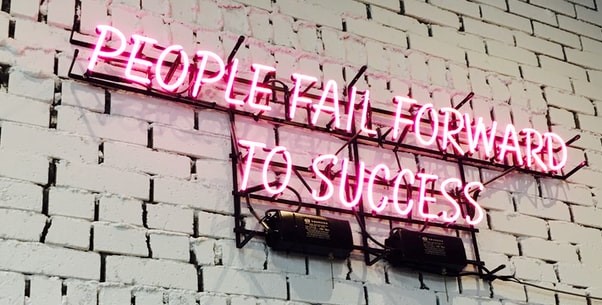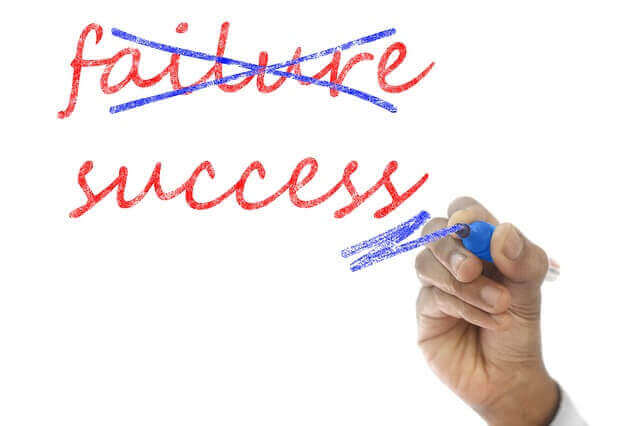FAIL!
If you try a lot of things, one might work.
– Tom Peters
Business success and innovation can only be discovered when we’re open to failure. We, therefore, need to learn how to fail; we need to create organizations and an environment that accepts failure as an invaluable learning tool.

Failure in the business world, among entrepreneurs and highly successful businesses, is nothing new. If we look at great inventors throughout history, all innovation, or creation as I like to call it, comes from small wins. It comes from exploiting and learning from the thousands of “so-called mistakes” along the way in which one’s initial approach did not work.
In today’s business world, however, too many organizations focus on reducing failure, taking calculated risks and sticking to the processes in an effort to try and tweak the work into logical, hierarchical thinking and hyperefficiency. That will not work if what we want to achieve is creative disruption, often referred to as “innovation.” Apple is a perfect example of this. Looking from the outside at companies like Apple, it’s easy to view them as perfect. But, if you look more closely behind the scenes, you’ll find that there have been major screw-ups.
Five of the biggest mistakes Apple made are worth reading up on.
1. Apple Lisa (1983-1985)
2. Macintosh Portable (1989-1991)
3. Apple Newton MessagePad (1993-1998)
4. Pippin (1995-1996)
5. Apple USB Mouse (1998-2000)
How did Apple overcome such major blunders? They learned to identify and celebrate “important failures.” They’ve integrated into their culture a mindset that there are many beautiful things to learn from failures. We very often neglect or even punish individuals for failure, but they take a totally different approach. They use it as an opportunity to learn, to grow and to refine internal and external processes.
Good leaders in any organization understand the value of failure. They understand that when we talk about creation (innovation), there are no ”eureka moments.“ More often than not, innovation and disruption stems from more of a process of “trail & error” which can only be cultivated in diverse and trusted environments. Equally important, good leaders also really understand the difference between bold, stupid ”Cowboy-Moves“ and inevitable failures that are made while on a clear path to trying to “change the world.”
We obviously should avoid making the same mistakes over-and-over again and strive to eliminate bold stupid failures. At the same time, we should foster the art of accepting real failures. In other words, instead of only rewarding the individual who is present when the breakthrough finally occurs (i.e. the invention of the “Dyson G-Force“), we should always maintain our focus onrewarding the participation, accomplishments and contributions of other team members throughout the process of trial and error (great success is never achieved as a one-man endeavor).
In today’s business world however, we very often reward the wrong people. It is always the one at the end (who get the glory). While we know the names of countless famous inventors and geniuses, it very often was co-creation and collaboration that led to many of the great achievements in the world. Unfortunately, we have become accustomed to one man or one person getting the fortune and fame. Yet, if we take a closer look, we see that without co-creation and collaboration, innovation and disruption would not have been possible. For such creativity and risk taking to occur – so that all opportunities available can be exploited – there must be an environment that supports it. This is what we like to call a strong culture or mode upon which this type of environment can be built.
So how do we create a culture for accepting and mastering the beautiful things to learn from failures, a culture of openness and trust (a winning team if you like)?:
- COLLABORATION AND CONNECTION
Focus on collaboration. Encourage people to engage in discussions. Intentionally create “open environments” where small, diverse teams can come together to share creative ideas. Move away from solutions and instead, see the value in getting people to ask questions.
What is an open environment? The best analogy is the coffee-house-talks, where we goof around with our friends about conquering the world. These are the real “innovation-centers.” Why? Because, in a trusted space and collaboration mode, everyone brings out the strengths and diverse opinions of others in the group.
When we see how good or great organizations work, we often talk about teamwork. Teamwork is where everyone sticks to their own part and solely focuses on doing his or her job. Collaboration, on the other hand, is something more. It’s about synergy. When there is synergy everything expands, grows and increases. 1+1 no longer equals two. 1+1 has the potential to equal three (or even greater). Synergy, then, naturally occurs when there is collaboration and connection.
- COMMUNICATION AND PROGRESS
It is important to have an open solution for communication that helps employees and colleagues be a part of a network in which they can interact, participate, comment and share. Networks are invaluable because they outscore hierarchies. Top-down and bottom up thinking is dead. They only stifle creativity and innovation.
As leaders, we also need to cultivate a working atmosphere that encourages and rewards (forward) progress. We need to see beyond starting and ending. We need to be facilitators of the process of constantly taking things in and moving thing out. This requires continuous communication of progress and trusted interaction between colleagues. It also requires transparency.
- EMPLOYEES TO COLLEAGUES
Move away from the traditional concept of employees. Begin viewing your staff and team members as colleagues. The hierarchical structure always loses to the open and trusted network of colleagues. Building effective teams begins with building real relationships that are based on empathy and trust. It can all start with an honest “Thank You,“ “How are you today?” or even a warm hug and supportiveness when someone is feeling down.
The concept of viewing your team members as colleagues is also about building a solid foundation for handling crisis together. In the army, for example, a lifetime of relationships are created from having mastered managing crisis as a team. The same is true in the culture of an organization. Individuals are willing to go the extra mile, to be vulnerable and to trust. Because of the bonds that are formed and the sense of mutual respect, colleagues are able to work together to think through and discover different solutions.
- RECOGNIZE INITIATIVES
One of the most highly underestimated competences is recognizing the desire to be treated as a human being and being acknowledged for one’s accomplishment – even if It did not lead to the big-bang. You always want to build the confidence of your employees (colleagues) so that their talents can be fully exploited. Therefore, it’s important not to “micromanage.”
Even more, as a leader, you have to be willing to take risks and encourage your colleagues to do the same. Like playing soccer, there needs to be a balance between defense and offense. You want to protect the resources and progress made by your company or organization by always making sound decisions and being defensive when necessary. Simultaneously, you need to know when to be on the attack, when to be aggressive and that unless you’re willing to take risks you’ll never score a goal. As part of the process, teams and organizations, therefore, must be willing to take risks and pursue certain initiatives together.
In order to develop an openness to new initiatives and risk-taking, the leaders of an organization must first learn to view and accept screw-ups as part of the process. This includes, as part of its routine, taking annual inventory of the screw-ups of the year alongside the biggest achievements. Foremost, when the highest value is placed on treating colleagues like human beings and maintaining an open and trusted environment, the organization has the best chance, as Darwin states, of remaining “fit.” It also has the best chance of cultivating highly effective teams.
Organizations that have a central focus on supporting and encouraging their colleagues to reach their full potential, by maximizing their talents, – instead of only focusing on the technology – are best positioned to disrupt itself at the right time and (not become) the next Nokia, Blackberry or Kodak. In such a workspace the “Wild Wisdom”, or the “Viscous Knowledge” flows and people accept that we all make mistakes, screw-up and that we are not perfect robotic structures; rather, we are human beings.
Business success requires a team effort in which leaders are equipped to effectively lead and colleagues are empowered to maximize their contribution. When true teams exist, they not only effectively respond to crisis, they possess the ability to quickly learn and adapt. This enables the organization to always steadily progress even when it seems as though it has stagnated.
– ANDERS INDSET
Anders Indset is a Vivaldi Partners Group advisory board member, serial-entrepreneur, management-thinker and sought-after speaker in the fields of leadership, branding and innovation. Indset talks about trends of tomorrow and how leaders can handle the current speed of change and how the post information-/knowledge society – the era of the “mensch” – will affect the business world and brands in the future in his speeches and in daily work with global leaders.
